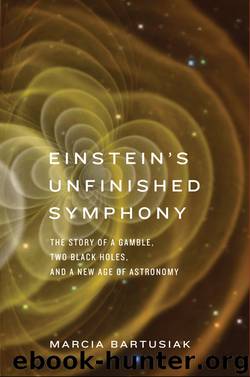Einstein’s Unfinished Symphony by Marcia Bartusiak

Author:Marcia Bartusiak
Language: eng
Format: epub
ISBN: 9780300223392
Publisher: Yale University Press
Richard Isaacson, the NSF’s former program director of gravitational physics, in 1995. Photograph by Tatiana Divens, courtesy AIP Emilio Segre Visual Archives, Divens Collection.
With this decision, gravity-wave astronomy moved toward the big leagues. Weiss, Drever, and Thorne were in charge of overseeing the new collaboration. Given Thorne’s Russian connection, the three came to be known as the “troika.” The troika’s first order of business was to assemble a detailed construction plan for two full-scale interferometers, which had been reduced to having four-kilometer (two-and-a-half-mile) arms owing to budget and engineering considerations. (The available sites, for one, were limited in size.) The NSF’s response to their initial ideas, though, was decidedly cool. Their suggested schemes were judged not good enough to be viable, especially in an era when federal budget woes were putting the brakes on other big science projects. “Caltech and MIT were simply not ready. Their plans were premature,” said Isaacson, who rose to become NSF’s program director of gravitational physics and is now retired.
As a result, the troika went back to the drawing board to rework their plans. “Each step forward in the scientific community or the governmental funding process required the interruption of exciting progress in laboratory research or conceptual insights,” recalled Isaacson. “Endless dog-and-pony shows, each demanded another week of preparation.” During this period of turmoil, Isaacson and Weiss would occasionally meet, walking around Walden Pond outside Boston to deliberate uninterrupted. In the end, the troika continued to get lukewarm critiques. Normally, that would have been the death knell for a proposed science endeavor, but Isaacson and Marcel Bardon, then director of NSF’s division of physics, had faith in the idea and pulled every string to keep the project alive. They made sure that money was provided to continue research and development on the proposal. “Bardon in particular recognized the technological promise,” recalled Isaacson. “The intellectual excitement was overwhelming. But what we had to do was reduce the risks. We wanted to nurture the dream until Caltech and MIT were up to the job of managing such a project.”
Download
This site does not store any files on its server. We only index and link to content provided by other sites. Please contact the content providers to delete copyright contents if any and email us, we'll remove relevant links or contents immediately.
| Aeronautics & Astronautics | Astronomy |
| Astrophysics & Space Science | Comets, Meteors & Asteroids |
| Cosmology | Mars |
| Solar System | Star-Gazing |
| Telescopes | UFOs |
Tools of Titans by Timothy Ferriss(8213)
Turbulence by E. J. Noyes(7935)
Secrets of Antigravity Propulsion: Tesla, UFOs, and Classified Aerospace Technology by Ph.D. Paul A. Laviolette(5309)
Astrophysics for People in a Hurry by Neil DeGrasse Tyson(5130)
Room 212 by Kate Stewart(5035)
Design of Trajectory Optimization Approach for Space Maneuver Vehicle Skip Entry Problems by Runqi Chai & Al Savvaris & Antonios Tsourdos & Senchun Chai(5011)
Pale Blue Dot by Carl Sagan(4907)
The David Icke Guide to the Global Conspiracy (and how to end it) by David Icke(4624)
A Journey Through Divination and Astronomy by Publishing Pottermore(4340)
Goodbye Paradise(3724)
Apollo 8 by Jeffrey Kluger(3635)
COSMOS by Carl Sagan(3553)
Losing the Nobel Prize by Brian Keating(3498)
The Five People You Meet in Heaven by Mitch Albom(3474)
How to Read Water: Clues and Patterns from Puddles to the Sea (Natural Navigation) by Tristan Gooley(3406)
Brief Answers to the Big Questions by Stephen Hawking(3369)
How to Read Nature by Tristan Gooley(3249)
The Order of Time by Carlo Rovelli(3144)
A Brief History of Time by Stephen Hawking(2959)
